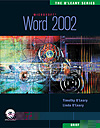|
 |  Office XP Word 2002, 2/e Timothy O'Leary
Creating and Editing a Document
Concepts
Lab 1: Creating and Editing a Document
The following concepts will be introduced in this lab:
- Template: A template is a document file that includes predefined settings that are used as a pattern to create many common types of documents.
- Automatic Grammar Check: The automatic grammar-checking feature advises you of incorrect grammar as you create and edit a document, and proposes possible corrections.
- AutoText and AutoComplete: The AutoText feature includes entries, such as commonly used phrases, which can be quickly inserted into a document. If the AutoComplete feature is on, a ScreenTip appears as you type the first four characters of an AutoText entry that suggests the remainder of the AutoText entry you may want to use.
- AutoCorrect: The AutoCorrect feature makes some basic assumptions about the text you are typing and, based on these assumptions, automatically corrects the entry.
- Automatic Spelling Check: The automatic spelling-checking feature advises you of misspelled words as you create and edit a document, and proposes possible corrections.
- Word Wrap: The word wrap feature automatically decides where to end a line and wrap text to the next line based on the margin settings.
- Font and Font Size: A font, also commonly referred to as a typeface, is a set of characters with a specific design that has one or more font sizes.
- Alignment: Alignment is how text is positioned on a line between the margins or indents. There are four types of paragraph alignment: left, center, right, and justified.
- Graphics: A graphic is a non-text element or object, such as a drawing or picture that can be added to a document.
|
|
|




 2002 McGraw-Hill Higher Education
2002 McGraw-Hill Higher Education